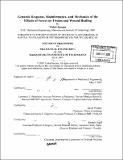| dc.contributor.advisor | Isaac Kohane. | en_US |
| dc.contributor.author | Saxena, Vishal, 1971- | en_US |
| dc.contributor.other | Massachusetts Institute of Technology. Dept. of Mechanical Engineering. | en_US |
| dc.date.accessioned | 2006-03-29T18:40:27Z | |
| dc.date.available | 2006-03-29T18:40:27Z | |
| dc.date.copyright | 2005 | en_US |
| dc.date.issued | 2005 | en_US |
| dc.identifier.uri | http://hdl.handle.net/1721.1/32391 | |
| dc.description | Thesis (Ph. D.)--Massachusetts Institute of Technology, Dept. of Mechanical Engineering, 2005. | en_US |
| dc.description | Includes bibliographical references (leaves 162-167). | en_US |
| dc.description.abstract | The mechanical environment of the cell is important for changes in behavior. Cellular behavioral changes can be traced to gene expression profile changes. These effects were studied in the context of Micromechanical force therapy, a novel therapeutic treatment in the management of different types of wounds. The mechanism of therapies that work by applying suction pressures is still not completely understood. It is proposed that micromechanical forces are the dominant mechanism by which they obtain accelerated wound healing. However, these therapies don't only impose forces to (wounded) tissue. They also remove edematous tissue as well as applies hypobaric oxygen conditions to the tissue. Therefore, it was decided first to study only the effects of pure forces on normal tissue. 50g forces were applied to rat ears in vivo. The ears were then sampled over a period of time for their gene expression profiles on Affymetrix RAE 230 2.0 gene chips. 8 time points were obtained for each of control and stretch conditions. One rat ear was chosen to be control (and without stretch), the other was stretched. A modified Gene set enrichment analysis (GSEA) on the expression profiles was conducted using the paired difference t statistic squared as the ranking metric. A further refinement which didn't use the sign of the t statistic looked at expression changes in either direction (the combined analysis). Important genesets were obtained relevant to the differences seen between control and stretch conditions. In the combined GSEA analysis, hypoxia came to the top of the gene set list followed by 'response to mechanical stimulus'. To test the significance of this result, a permutation test was conducted on the dataset. | en_US |
| dc.description.abstract | (cont.) By shuffling the class (control versus stretch) labels randomly, different permutations were created and the GSEA was run to see if the occurrence was a chance event. The P values obtained were 0.001 and 0.014 showing that both were significant because they were not enriched randomly. The hypoxia geneset could be an important modulator of forces in wound healing. Future work will test in a biological model the validity of the importance of hypoxia in this system. | en_US |
| dc.description.statementofresponsibility | by Vishal Saxena. | en_US |
| dc.format.extent | 167 leaves | en_US |
| dc.format.extent | 8967520 bytes | |
| dc.format.extent | 8977203 bytes | |
| dc.format.mimetype | application/pdf | |
| dc.format.mimetype | application/pdf | |
| dc.language.iso | eng | en_US |
| dc.publisher | Massachusetts Institute of Technology | en_US |
| dc.rights | M.I.T. theses are protected by copyright. They may be viewed from this source for any purpose, but reproduction or distribution in any format is prohibited without written permission. See provided URL for inquiries about permission. | en_US |
| dc.rights.uri | http://dspace.mit.edu/handle/1721.1/7582 | |
| dc.subject | Mechanical Engineering. | en_US |
| dc.title | Genomic response, bioinformatics, and mechanics of the effects of forces on tissues and wound healing | en_US |
| dc.type | Thesis | en_US |
| dc.description.degree | Ph.D. | en_US |
| dc.contributor.department | Massachusetts Institute of Technology. Department of Mechanical Engineering | |
| dc.identifier.oclc | 61661275 | en_US |
